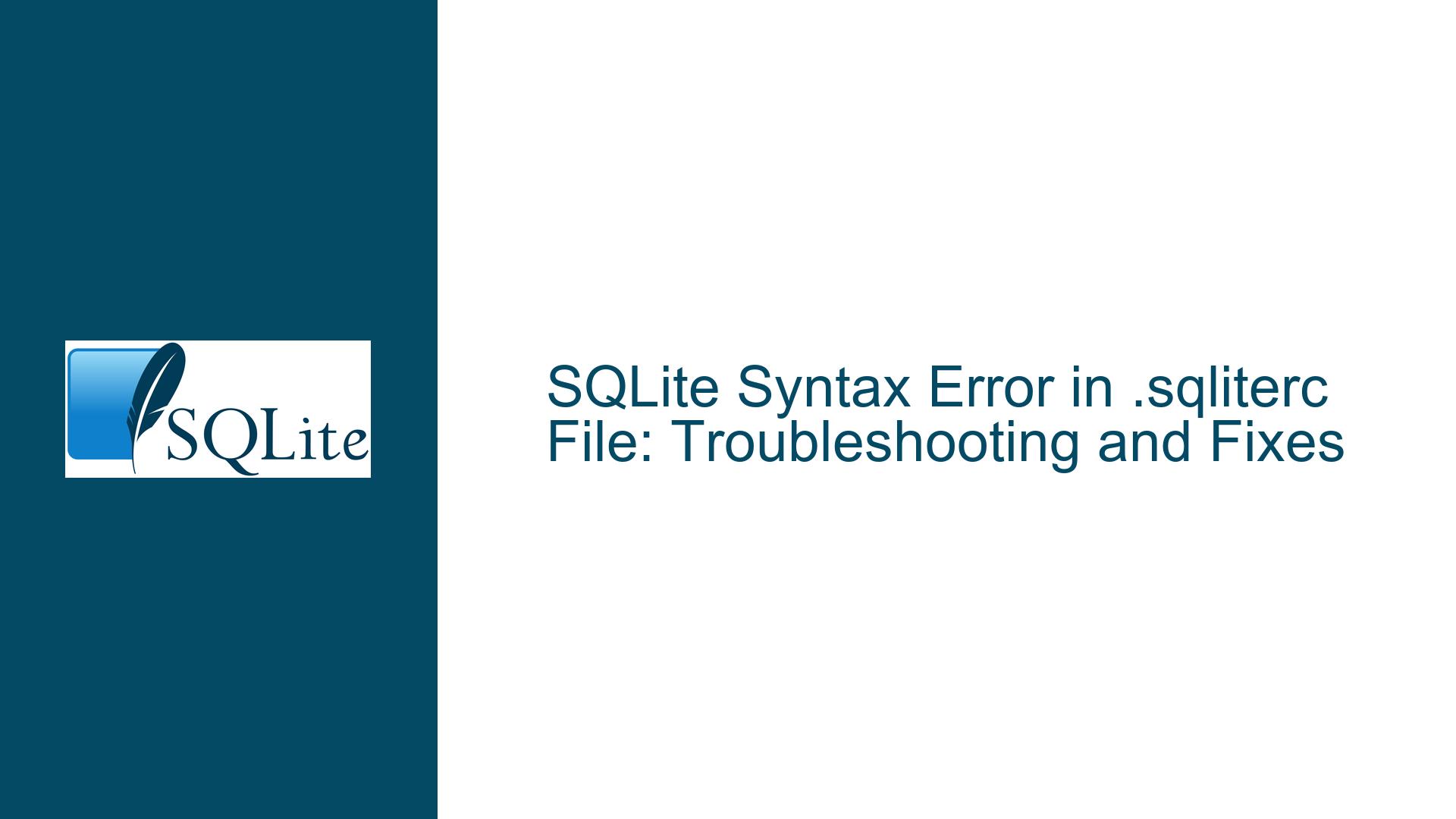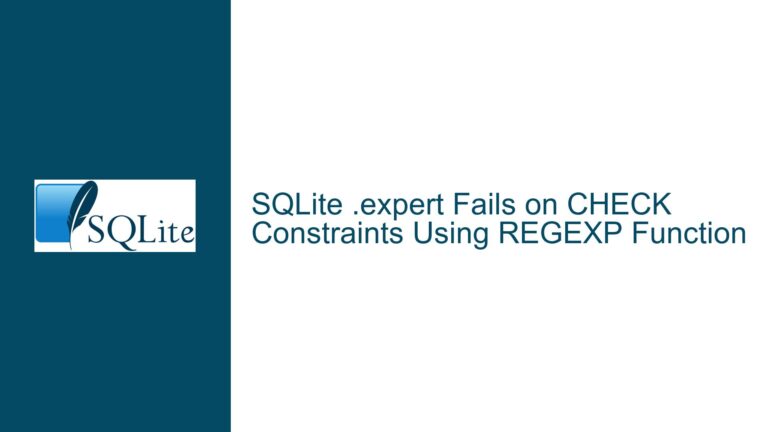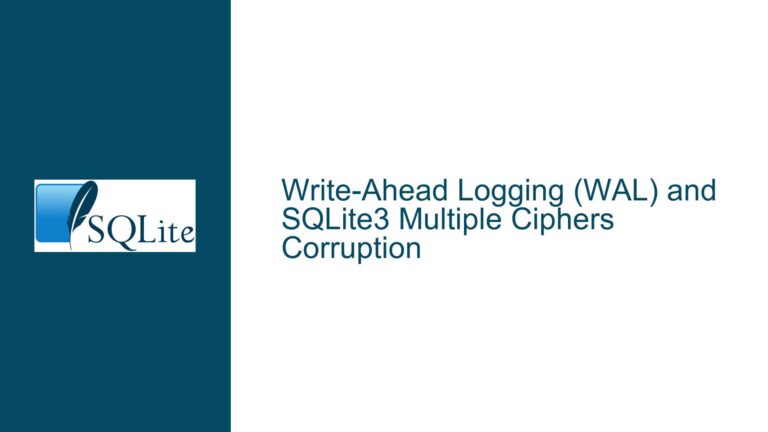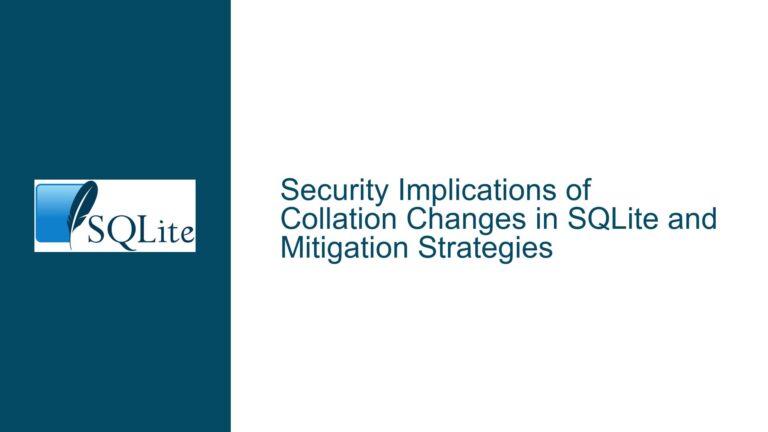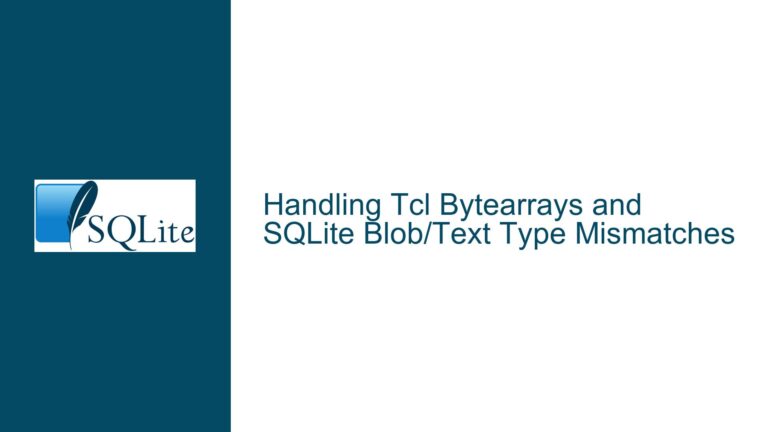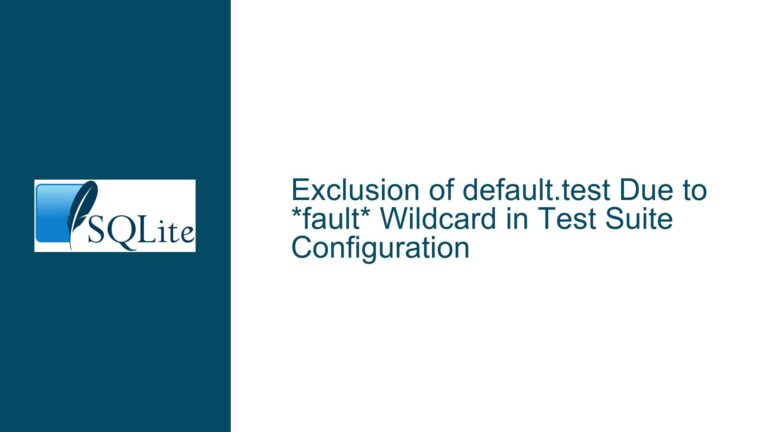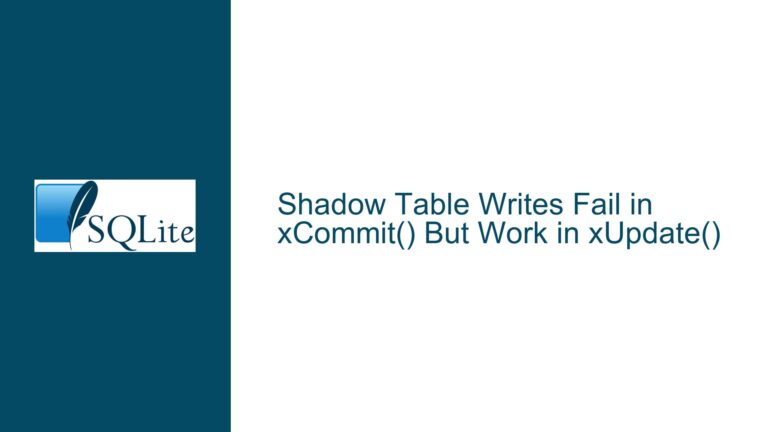SQLite Syntax Error in .sqliterc File: Troubleshooting and Fixes
Issue Overview: Syntax Error in .sqliterc Configuration File
When working with SQLite, configuration files such as .sqliterc can significantly enhance productivity by preloading settings, aliases, or frequently used queries. However, these files can also introduce errors if not properly formatted. In this case, the user encountered a syntax error when attempting to check the SQLite version using the sqlite3 -version command. The error message indicated a problem near an asterisk (*) on line 4 of the .sqliterc file located at /home/mg/.sqliterc. The specific error message was:
Error: near line 4: near "*": syntax error
This error prevented the SQLite command-line interface (CLI) from executing correctly, even for a simple version check. The issue stemmed from a malformed comment in the .sqliterc file, where a multi-line comment was missing the leading slash (/). This seemingly minor oversight caused the SQLite parser to misinterpret the content, leading to the syntax error.
Understanding the root cause of this issue requires a deeper dive into how SQLite processes configuration files, the syntax rules for comments, and the interplay between the SQLite CLI and external resources like .sqliterc. By dissecting the problem, we can explore not only the immediate fix but also best practices for avoiding similar issues in the future.
Possible Causes: Misconfigured .sqliterc File and Comment Syntax Errors
The primary cause of the error lies in the .sqliterc file, which is automatically loaded by the SQLite CLI when it starts. This file is intended to contain SQL commands or configuration settings that are executed or applied upon initialization. However, if the file contains syntax errors, SQLite will fail to process it, resulting in errors like the one encountered.
1. Malformed Multi-Line Comments in .sqliterc
SQLite supports both single-line and multi-line comments. Single-line comments begin with --, while multi-line comments are enclosed within /* and */. In this case, the user attempted to use a multi-line comment but omitted the leading slash (/), resulting in:
* comment */
This incomplete comment syntax caused the SQLite parser to encounter an unexpected asterisk (*), which it interpreted as a syntax error. The parser expects valid SQL commands or properly formatted comments, and any deviation from this can lead to errors.
2. Automatic Loading of .sqliterc
The SQLite CLI automatically loads the .sqliterc file from the user’s home directory unless explicitly disabled. This behavior is designed to streamline workflows but can inadvertently introduce errors if the file contains invalid syntax. The error message explicitly pointed to line 4 of the file, indicating that the issue was localized to that specific line.
3. Resource Loading Mechanism
The error message also included a note about loading resources from /home/mg/.sqliterc. This indicates that the SQLite CLI attempted to load the file but encountered a syntax error during the process. Understanding how SQLite handles resource loading is crucial for diagnosing and resolving such issues.
4. User-Specific Configuration Files
The .sqliterc file is user-specific, meaning it resides in the user’s home directory and is unique to their environment. This can lead to inconsistencies if the file is shared across different systems or edited without proper validation. Ensuring the file’s integrity is essential for preventing errors.
Troubleshooting Steps, Solutions & Fixes: Diagnosing and Resolving Syntax Errors in .sqliterc
Resolving the issue involves a systematic approach to diagnosing the problem, correcting the syntax error, and implementing best practices to prevent future occurrences. Below is a detailed guide to troubleshooting and fixing the issue.
1. Identifying the Problematic Line in .sqliterc
The first step is to locate and inspect the .sqliterc file. The error message provided the file path (/home/mg/.sqliterc) and indicated that the issue was near line 4. To view the contents of the file, use the following command:
cat /home/mg/.sqliterc
This command will display the contents of the file in the terminal, allowing you to identify the problematic line. In this case, the issue was a malformed multi-line comment missing the leading slash (/).
2. Correcting the Syntax Error
Once the problematic line is identified, the next step is to correct the syntax error. For multi-line comments, ensure that the comment is properly enclosed within /* and */. In this case, the correction involves adding the missing slash:
/* comment */
After making the correction, save the file and verify that the syntax error is resolved.
3. Testing the Configuration File
After correcting the syntax error, test the .sqliterc file to ensure it loads without issues. Run the following command to check the SQLite version:
sqlite3 -version
If the file is correctly formatted, the command should display the SQLite version without any errors. For example:
3.31.1 2020-01-27 19:55:54 3bfa9cc97da10598521b342961df8f5f68c7388fa117345eeb516eaa837balt1
4. Disabling Automatic Loading of .sqliterc (Optional)
If you suspect that the .sqliterc file may cause issues in the future, you can temporarily disable its automatic loading. This can be done by renaming the file or moving it to a different location. For example:
mv /home/mg/.sqliterc /home/mg/.sqliterc_backup
This will prevent the SQLite CLI from loading the file upon startup. You can later restore the file by reversing the command.
5. Validating .sqliterc Content
To avoid syntax errors, validate the content of the .sqliterc file before using it. Ensure that all SQL commands and comments are correctly formatted. You can use an SQLite validator or manually test each command in the SQLite CLI.
6. Implementing Best Practices for .sqliterc
To prevent similar issues in the future, follow these best practices when working with .sqliterc files:
- Use Proper Comment Syntax: Always use the correct syntax for comments. Single-line comments should begin with
--, and multi-line comments should be enclosed within/*and*/. - Test Changes Incrementally: After making changes to the
.sqlitercfile, test each modification to ensure it does not introduce errors. - Backup the File: Regularly back up the
.sqlitercfile to avoid losing custom configurations. - Document Customizations: Maintain documentation for any customizations made to the
.sqlitercfile, including the purpose of each command or setting.
7. Understanding SQLite Resource Loading
SQLite automatically loads resources like .sqliterc from the user’s home directory. Understanding this behavior is crucial for diagnosing issues related to configuration files. If you encounter errors, check the resource loading process and ensure that all referenced files are correctly formatted.
8. Exploring Alternative Configuration Methods
If the .sqliterc file becomes too complex or error-prone, consider alternative configuration methods. For example, you can use command-line arguments or environment variables to customize SQLite behavior without relying on a configuration file.
9. Debugging with Verbose Output
For more complex issues, enable verbose output to gain additional insights into the SQLite CLI’s behavior. This can help identify the root cause of errors and provide more detailed information for troubleshooting.
10. Seeking Community Support
If you are unable to resolve the issue, consider seeking support from the SQLite community. Forums, mailing lists, and documentation can provide valuable insights and solutions for common problems.
By following these troubleshooting steps and implementing best practices, you can effectively diagnose and resolve syntax errors in the .sqliterc file, ensuring a smooth and error-free experience with SQLite. Understanding the nuances of SQLite’s configuration and resource loading mechanisms is key to maintaining a robust and efficient workflow.
